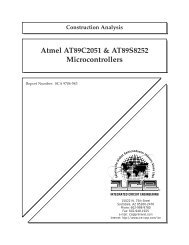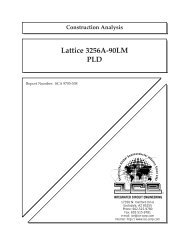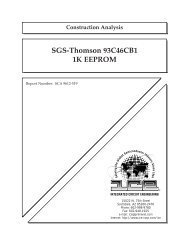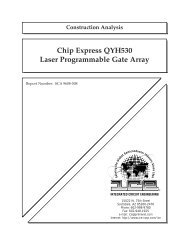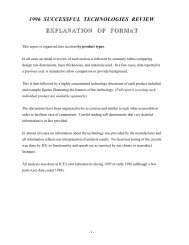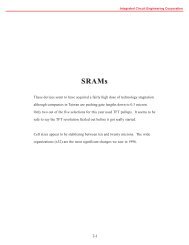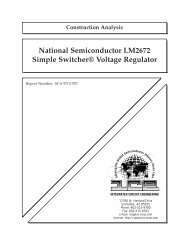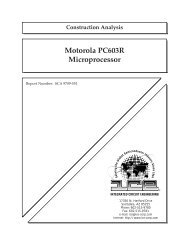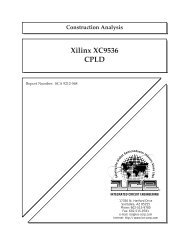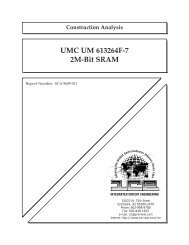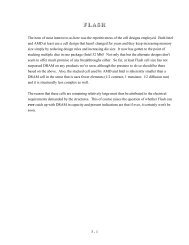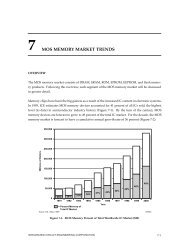Chapter 2. COST PER WAFER - Smithsonian - The Chip Collection
Chapter 2. COST PER WAFER - Smithsonian - The Chip Collection
Chapter 2. COST PER WAFER - Smithsonian - The Chip Collection
Create successful ePaper yourself
Turn your PDF publications into a flip-book with our unique Google optimized e-Paper software.
2 Cost Per Wafer<br />
Cost per wafer is perhaps the most widely<br />
used cost metric in the semiconductor industry.<br />
Its value lies in the ability to combine<br />
large quantities of cost data and obtain one<br />
indicator of operating cost that can be used to<br />
compare different pieces of equipment, different<br />
processes, alternative materials, etc. Cost<br />
per wafer can also be used as a benchmarking<br />
metric (see <strong>Chapter</strong> 4, Fab Benchmarking). It<br />
can further be used to estimate a fair price for<br />
foundry-produced wafers.<br />
Information from the Semiconductor<br />
Industry Association in the U.S. indicates<br />
that average cost per wafer has increased by<br />
3X over the last 15 years (Figure 2-1).<br />
Although the cost of labor, materials and<br />
capital expenditures per wafer have<br />
increased, the real cost of manufacturing<br />
semiconductor chips continues to decrease<br />
because the number of transistors that can be<br />
placed on a wafer has grown faster than<br />
manufacturing costs, as shown in Figure 2-<strong>2.</strong><br />
As discussed in <strong>Chapter</strong> 1, this ever-increasing<br />
cost per wafer is offset by the ability to<br />
shrink feature size by 30 percent each<br />
device generation, thereby decreasing the<br />
manufacturing cost per transistor. <strong>The</strong><br />
effective price of DRAMs, measured in cost<br />
per bit, falls by 30 percent per year. Rising<br />
manufacturing cost is further offset by manufacturersÕ<br />
ability to continually increase<br />
device yields, transition to larger wafers<br />
sizes and increase the productivity of fab<br />
equipment and operations. By continually<br />
decreasing or controlling cost per wafer, IC<br />
manufacturers can increase profitability.<br />
Cost per wafer at the fab level can be simply<br />
computed using the total cost of manufacturing<br />
divided by the total number of yielded<br />
wafers produced. Cost per wafer at the<br />
equipment level is typically computed Òfrom<br />
the ground-upÓ using the cost of equipment<br />
depreciation, cost of direct labor, maintenance<br />
and materials, cost of energy and other<br />
facilities as well as building depreciation<br />
costs.<br />
Cost per wafer first enjoyed widespread use<br />
several years following the introduction of<br />
cost-of-ownership modeling by SEMAT-<br />
ECH, the consortium of semiconductor manufacturers<br />
in the U.S. Cost per wafer is often<br />
used to compare the cost-of-ownership performance<br />
of competing pieces of equipment.<br />
It is also used by semiconductor manufacturers<br />
for benchmarking purposes, and to<br />
assess the cost of making process modifications<br />
and adopting new processes.<br />
Importantly, however, one of the most critical<br />
components in cost-of-ownership calculations<br />
is the yield of the given process step.<br />
Because yield influences cost so dramatically<br />
and because yield is very difficult to determine<br />
on a step-by-step basis, most COO calculations<br />
assume identical yields from one<br />
process tool to another. For more discussion<br />
on COO see <strong>Chapter</strong> 4, Fab Benchmarking.<br />
INTEGRATED CIRCUIT ENGINEERING CORPORATION 2-1



